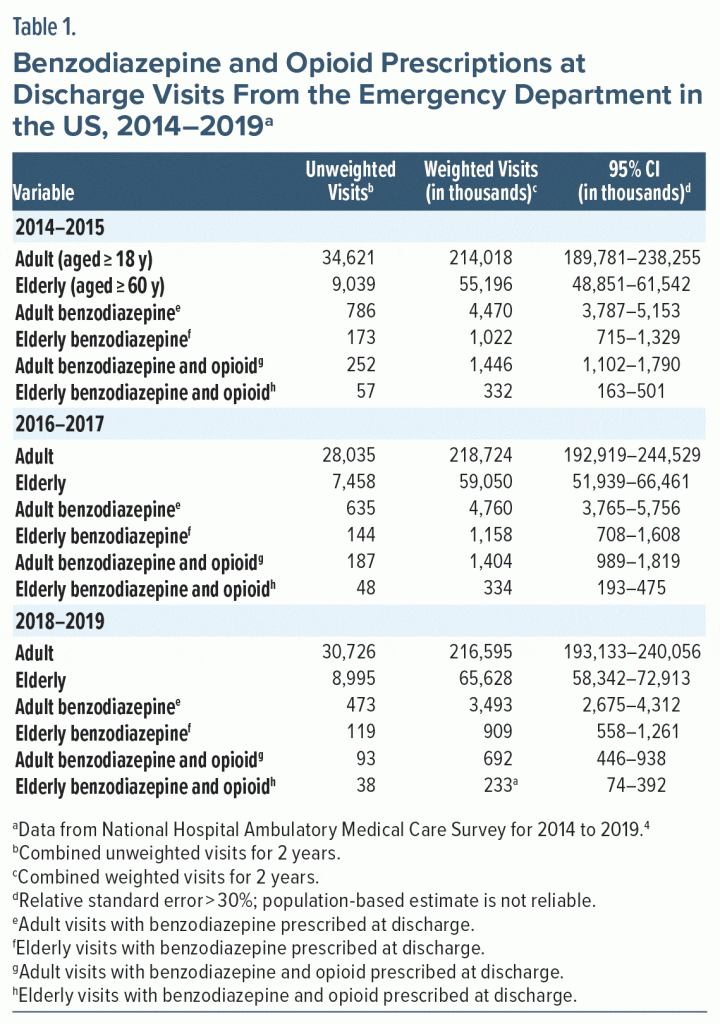Prescription opioid overdose deaths have steadily increased across the United States.1 Thirty percent of these deaths involve benzodiazepines.2 Decreasing benzodiazepine prescriptions and avoiding coprescribing opioids can lower overdose mortality.
Coprescribing opioids with naloxone has increased, which can also decrease overdose mortality.3 Naloxone prescription trends in patients coprescribed opioids and benzodiazepines are unknown.
This study analyzed the emergency department (ED) visits with benzodiazepines prescribed at discharge, with and without opioids, for 2014–2019. We also evaluated naloxone prescription on visits in which benzodiazepines and opioids were coprescribed.
METHODS
We performed a secondary analysis of publicly available de-identified data from the National Hospital Ambulatory Medical Care Survey (NHAMCS) for 2014 to 2019.4 NHAMCS is an annual survey of ED visits of nonfederal hospitals across the United States. We used Cerner Multum third-level therapeutic category codes (https://wwwn.cdc.gov/NCHS_Ambulatory_Drugs/) to define benzodiazepines (codes 69 and 203) and opioids (codes 60 and 191). For naloxone, we used the medication codes 20310 and 60995.
We used sample visit weights for a national estimate and examined all 30 listed medications. Adult visits (age ≥ 18 years) and elderly visits (age ≥ 60 years) were analyzed separately. “Prescribed” was defined as when medication was given only at discharge or in the ED and at the time of discharge.
The 3 visit groups analyzed were (1) benzodiazepines prescribed, (2) benzodiazepines and opioids prescribed, and (3) benzodiazepines, opioids, and naloxone prescribed.
We combined data into 2-year groups (2014 with 2015, 2016 with 2017, and 2018 with 2019) and defined “annual visits” as a mean of 2-year visits.
All estimates were based on over 30 unweighted samples and a relative standard error (RSE) of < 30%. The study was exempt from the institutional review due to the use of de-identified data. We used IBM SPSS version 28 with complex sampling module for analysis.
RESULTS
In 2014–2015, 2.1% of adult visits (2.23 million annual visits) and 1.9% of elderly visits (511,000) had benzodiazepines prescribed. In 2016–2017, 2.2% of adult ED visits (2.38 million annual visits) and 2% of elderly visits (579,000) had benzodiazepines prescribed, while in 2018–2019, these values decreased to 1.6% of adult visits (1.74 million annual visits) and 1.4% of elderly visits (454,000 annual visits) (Table 1).
In 2014–2015, 0.7% of adult visits (723,000 annual visits) had a benzodiazepine and an opioid coprescribed; in 2016–2017, this value decreased to 0.6% (702,000 annual visits), while in 2018–2019, this value further decreased to 0.3% (346,000 annual visits). In addition, in 2014–2015, 32.3% of adult benzodiazepine visits had opioids coprescribed, which decreased to 19.8% in 2018–2019.
Elderly annual visits with coprescribed opioids and benzodiazepines were 166,000 in 2014–2015 and 167,000 in 2016–2017. However, for 2018–2019, the population estimate was not calculated, as the RSE was > 30% (Table 1).
Naloxone was prescribed in only 1 unweighted opioid and benzodiazepine visit.
DISCUSSION
The benzodiazepines prescribed from the ED decreased from 2.1% to 1.6% of adult visits during the study period. A more pronounced decrease was found in the benzodiazepine and opioid–prescribed visits, for which the percentage decreased by almost half. This finding aligns with that of an early study5 that reported a similar decline after 2016 due to various policy and regulatory changes.
A similar downward trend was observed in elderly benzodiazepine-prescribed visits, which decreased from 1.9% to 1.4%. Again, these are reassuring findings; however, while regulatory and policy changes may be responsible, further study is needed to understand any other potential factor.
However, only 1 ED visit had naloxone prescribed with opioids and benzodiazepines, which is concerning.
Our study has several limitations. First, the NHAMCS is a sample representative of visits, not patients, and lacks information about dosage, adherence, or the number of refills given. Furthermore, the result is generalizable only to nonfederal ED visits.
CONCLUSION
Between 2014 and 2019, the number of visits with benzodiazepines prescribed at discharge from the emergency department with and without opioids decreased. However, naloxone continues not to be prescribed in visits with coprescribed opioids and benzodiazepines.
Article Information
Published Online: October 3, 2023. https://doi.org/10.4088/PCC.23br03530
© 2023 Physicians Postgraduate Press, Inc.
Prim Care Companion CNS Disord. 2023;25(5):23br03530
Submitted: March 22, 2023; accepted May 18, 2023.
To Cite: Rizvi A, Yadava D, Nolte C. Benzodiazepines prescribed with and without opioids at discharge from the emergency department: a serial cross-sectional study of National Hospital Ambulatory Medical Care Survey data for 2014–2019. Prim Care Companion CNS Disord. 2023;25(5):23br03530.
Author Affiliations: Department of Behavioral Medicine and Psychiatry, West Virginia University, Morgantown, West Virginia (all authors).
Corresponding Author: Abid Rizvi, MD, Department of Behavioral Medicine and Psychiatry, West Virginia University, 936 Sharpe Hospital Road Weston, Morgantown, WV 26452 ([email protected]).
Relevant Financial Relationships: None.
Funding/Support: None.
Additional Information: The original data set for the National Hospital Ambulatory Medical Care Survey (NHAMCS) is available from the National center for health statistics and can be assessed at https://ftp.cdc.gov/pub/Health_Statistics/NCHS/Datasets/NHAMCS/.
References (5)

- Drug overdose death rates. National Institutes of Health website. Published March 8, 2023. Accessed March 11, 2023. https://nida.nih.gov/research-topics/trends-statistics/overdose-death-rates
- Bachhuber MA, Hennessy S, Cunningham CO, et al. Increasing benzodiazepine prescriptions and overdose mortality in the United States, 1996–2013. Am J Public Health. 2016;106(4):686–688. PubMed CrossRef
- Ramdin C, Chandran K, Nelson L, et al. Trends in naloxone prescribed at emergency department discharge: A national analysis (2012–2019). Am J Emerg Med. 2023;65:162–167. PubMed CrossRef
- National Hospital Ambulatory Medical Care Survey (NHAMCS). Centers for Disease Control and Prevention website. Accessed March 1, 2023. https://ftp.cdc.gov/pub/Health_Statistics/NCHS/dataset_documentation/nhamcs/spss/
- Marwitz KK, Noureldin M. A descriptive analysis of concomitant opioid and benzodiazepine medication use and associated adverse drug events in United States adults between 2009 and 2018. Explor Res Clin Soc Pharm. 2022;5:100130. PubMed CrossRef
Please sign in or purchase this PDF for $40.
Save
Cite

